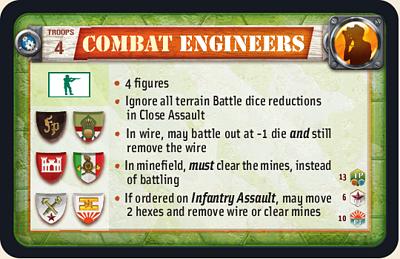Engineers Rules
Combat Engineer units were used throughout WWII to increase the combat effectiveness of the Corps. They provided mobility, counter−mobility, survivability, topographic and engineering support.An Engineer unit moves and battles like a Standard unit.
Most rules are on the following reference card:

- In Close Assault Combat, an Engineer unit ignores all terrain Battle dice reductions, i.e. their enemies are not protected by their terrain.
- An Engineer unit that is on a hex with wire will reduce the number of Battle dice it rolls by 1 and may also remove the wire from the hex on the same turn.
- An Engineer unit that moves onto a Minefield hex and that is eligible to battle must clear the Minefield hex instead of battling. If the Engineer unit cannot clear the Minefield, it detonates.
- An Engineer ordered by Infantry Assault, may move 2 hexes then remove wire or clear mines.
- An Engineer may clear a Roadblock obstacle instead of battling.
Nations and Badges
 |
GERMAN ENGINEERS The “Fp” arm badge shown here was for fortification construction engineers. |
 |
ITALIAN ENGINEERS The history of Italian Engineers dates as far back as the early 16th century. With the introduction of gunpowder and cannon, a new design had to be found for fortresses so that they would better resist these advances in warfare technology. The result was the “trace italienne”: star-shaped fortresses surrounding towns and even cities with outlying defenses. In the 1530s and 1540s, this new design spread from Italy throughout Europe, and Italian Engineers were in high demand. The concepts were refined over the centuries, and were still used durind the 1914-1418 Great War. |
 |
ROYAL ENGINEERS Royal Engineers have played an important role in all of the conflicts where Great Britain participated. For this reason, King William IV awarded them their ‘ubique’ motto in 1832, to explain that they had taken part in every battle fought by the British Army. During WWII, the Royal Engineers skills were extensively used for bomb disposal, mine detection, bridge building, etc. |
 |
US ENGINEERS The turreted castle is the symbol of the US Army Corps of Engineers. In heraldry, this symbol was used to describe men who overcame walled fortifications. The US Army started using this symbol in 1840. It was then used on various clothing elements such as epaulets, belt plates, caps, shoulder knots, buttons, etc. Even though the general shape would evolve, it has remained the distinctive symbol of the Corps of Engineers. |
 |
SOVIET ENGINEERS Combat Engineer units were used throughout WWII to increase the combat effectiveness of the Corps. They provided mobility, counter−mobility, survivability, topographic and engineering support. |
 |
JAPANESE ENGINEERS |